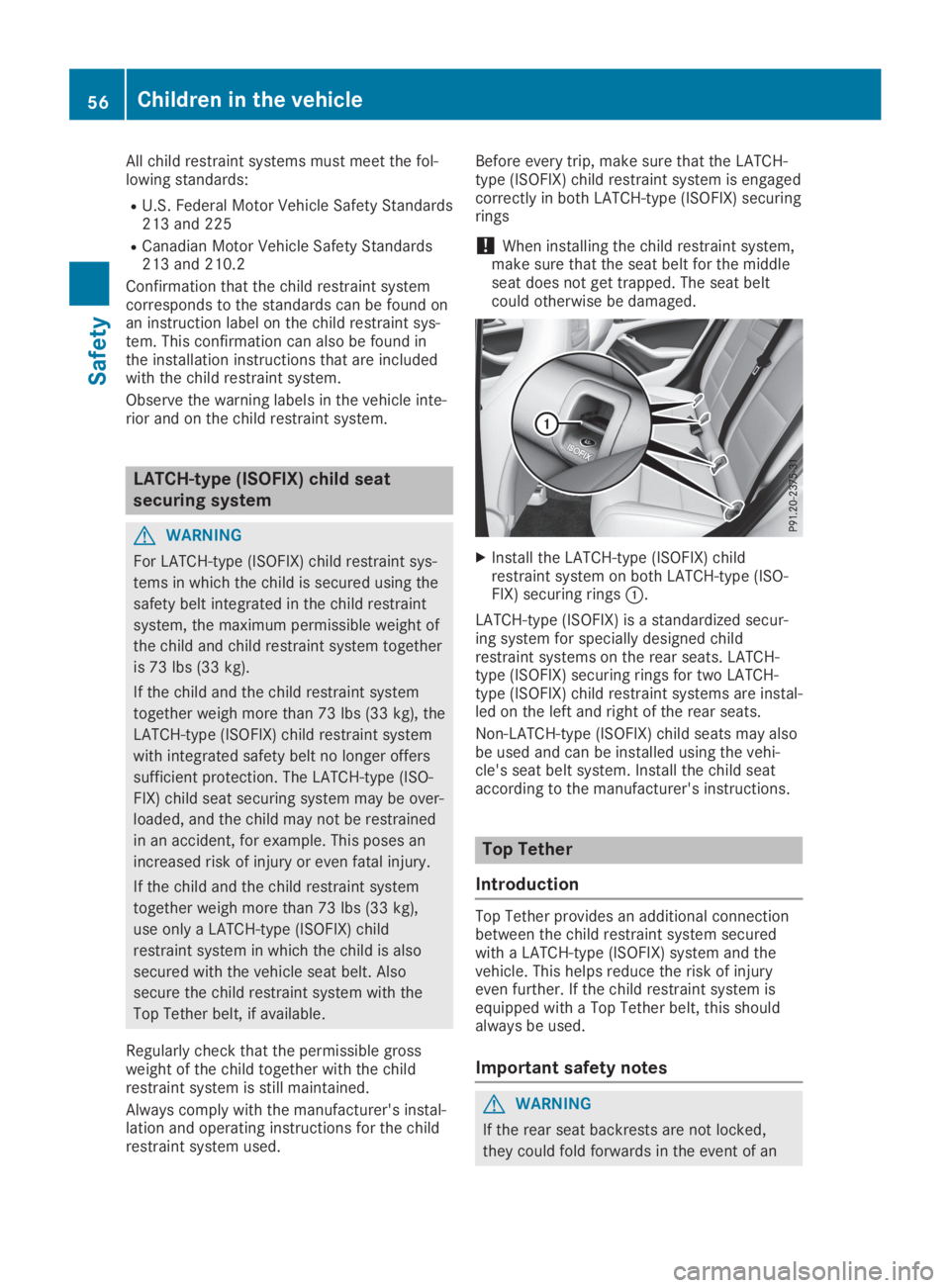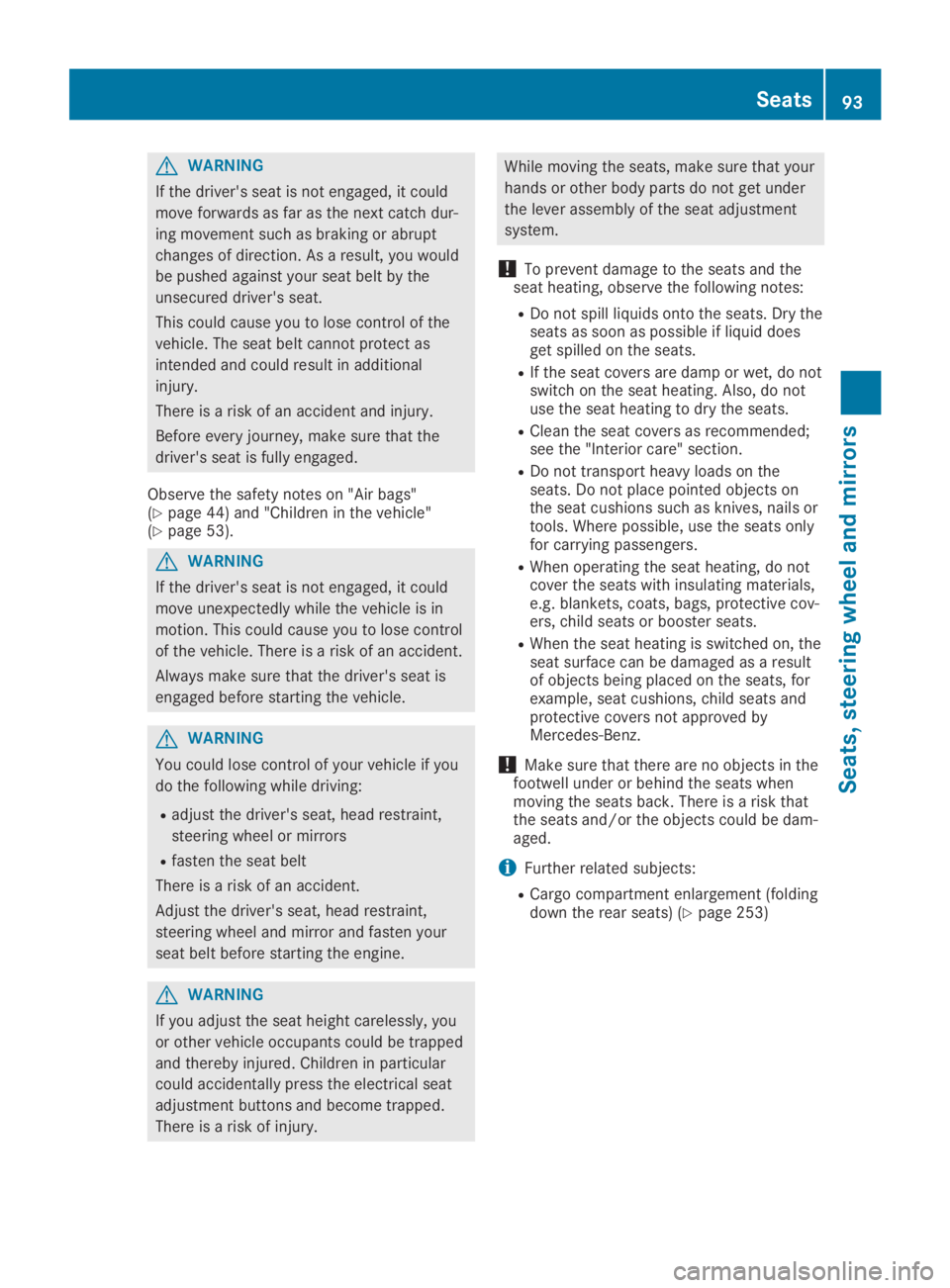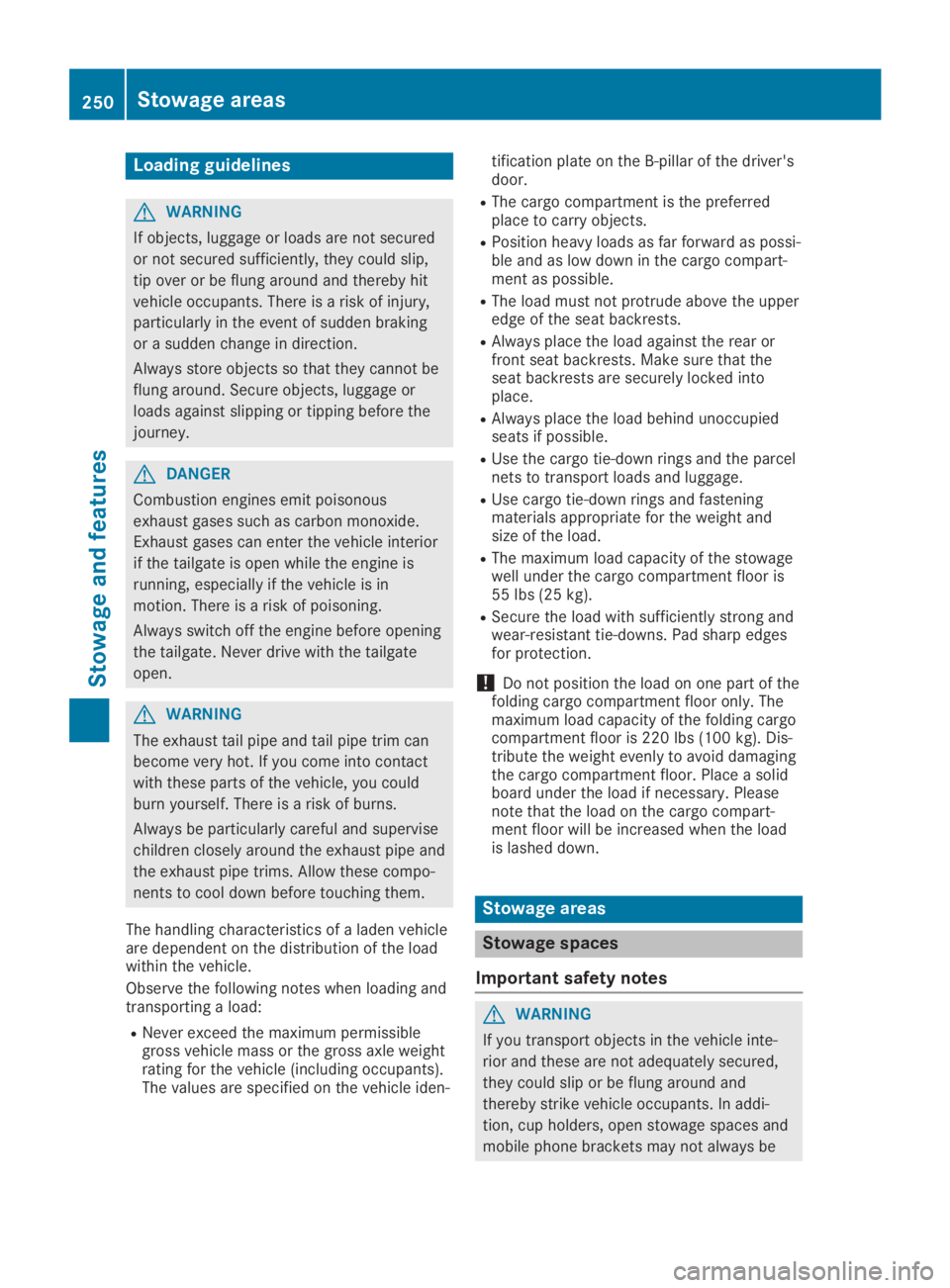2019 MERCEDES-BENZ GLA fold seats
[x] Cancel search: fold seatsPage 18 of 346

Parking lamps
Switching on/off ........................... 103
PASSENGER AIR BAG
Display message ............................213
Indicator lamps ................................ 40
Problem (malfunction) ................... 213
Pets in the vehicle............................... 59
Phone book
see also Digital Operator's Man-
ual ..................................................242
Plastic trim (cleaning instruc-
tions)..................................................284
Power washers.................................. 279
Power windows
see Side windows
Protection against theft
ATA (Anti-Theft Alarm system) ......... 68
Immobilizer ...................................... 67
Protection of the environment
General notes .................................. 25
Pulling away
Automatic transmission ................. 128
General notes ................................ 128
Hill start assist ............................... 128
Q
QR code
Mercedes-Benz Guide App ................. 1
Rescue card ..................................... 28
Qualified specialist workshop........... 27
R
RACE START
Important safety notes .................. 167
RACE START (Mercedes-AMG
vehicles)............................................. 167
RACE TIMER (on-board computer,
Mercedes-AMG vehicles).................. 201
Radio
Selecting a station ......................... 194
see Digital Operator's Manual
Radio mode
see also Digital Operator's Man-
ual ..................................................242
Radio-wave reception/transmis-
sion in the vehicle
Declaration of conformity ................ 27
Rain closing feature (panorama
roof with power tilt/sliding
panel).................................................... 89
REACH Regulation............................... 28
Reading lamp..................................... 105
Rear compartment
Setting the air vents ......................123
Rear fog lamp
Display message ............................ 215
Replacing bulbs .............................108
Switching on/off ........................... 103
Rear lamps
see Lights
Rear seat
Adjusting the angle of the backr-
ests ................................................ 254
Rear seats
Folding the backrest forwards/
back ............................................... 254
Rear view camera
"Reverse parking" function ............ 180
Cleaning instructions ..................... 283
Display in the multimedia system .. 179
Function/notes .............................178
General notes ................................ 178
Switching on/off ........................... 179
Rear window defroster
Problem (malfunction) ................... 122
Switching on/off ........................... 122
Rear window wiper
Replacing the wiper blade .............. 112
Switching on/off ........................... 110
Rear-view mirror
Anti-glare (manual) .......................... 98
Dipping (automatic) ......................... 99
Reflective safety jacket.................... 286
Refrigerant (air-conditioning sys-
tem)
Important safety notes .................. 338
Refueling
Fuel gauge ....................................... 32
Important safety notes .................. 142
Refueling process .......................... 143
see Fuel
16Index
Page 19 of 346

Remote control
Garage door opener ....................... 268
Programming (garage door
opener) .......................................... 268
Replacing bulbs
Brake lamp .................................... 108
High-beam headlamps................... 107
Important safety notes .................. 106
Installing/removing the cover
(front wheel arch) .......................... 107
Low-beam headlamps.................... 107
Overview of bulb types .................. 106
Rear fog lamp ................................ 108
Turn signals (front) ......................... 108
Turn signals (rear) .......................... 108
Rescue card......................................... 28
Reserve (fuel tank)
see Fuel
Reserve fuel
Display message ............................ 218
Warning lamp ................................. 238
see Fuel
Residual heat (climate control)........ 122
Restraint system
Display message ............................ 211
Introduction ..................................... 39
Warning lamp ................................. 237
Warning lamp (function) ................... 40
Reverse gear (selector lever)........... 136
Reversing feature
Roller sunblind ................................. 89
Side windows ................................... 83
Tailgate ............................................ 78
Roadside Assistance (breakdown).... 26
Roller sunblind
Panorama roof with power tilt/
sliding panel ..................................... 89
Roof carrier........................................ 256
Roof lining and carpets (cleaning
guidelines)......................................... 285
Roof load (maximum)........................ 339
Route guidance
see also Digital Operator's Man-
ual .................................................. 242
S
Safety
Children in the vehicle ..................... 53
see Occupant safety
Safety system
see Driving safety systems
SD card
Inserting ........................................ 249
Inserting/removing ........................ 248
Removing ....................................... 249
SD memory card
see also Digital Operator's Man-
ual .................................................. 242
Search & Send
see also Digital Operator's Man-
ual .................................................. 242
Seat
Correct driver's seat position ........... 92
Seat belts
Adjusting the height ......................... 43
Cleaning ......................................... 285
Correct usage .................................. 42
Fastening ......................................... 43
Important safety guidelines ............. 41
Introduction ..................................... 41
Releasing ......................................... 43
Warning lamp ................................. 230
Warning lamp (function) ................... 44
Seats
Adjusting (electrically) ..................... 94
Adjusting (manually) ........................ 94
Adjusting (Performance Seat) .......... 96
Adjusting the 4-way lumbar sup-
port .................................................. 96
Adjusting the head restraint ............ 95
Cleaning the cover ......................... 284
Folding the backrest (rear com-
partment) forwards/back .............. 254
Important safety notes .................... 92
Seat heating problem ...................... 97
Storing settings (memory func-
tion) ............................................... 101
Switching seat heating on/off......... 96
Section
Cargo compartment ......................... 77
Securing a load
see Securing cargo
Index17
Page 58 of 346

All child restraint systems must meet the fol-lowing standards:
RU.S. Federal Motor Vehicle Safety Standards213 and 225
RCanadian Motor Vehicle Safety Standards213 and 210.2
Confirmation that the child restraint systemcorresponds to the standards can be found onan instruction label on the child restraint sys-tem. This confirmation can also be found inthe installation instructions that are includedwith the child restraint system.
Observe the warning labels in the vehicle inte-rior and on the child restraint system.
LATCH-type (ISOFIX) child seat
securing system
GWARNING
For LATCH-type (ISOFIX) child restraint sys-
tems in which the child is secured using the
safety belt integrated in the child restraint
system, the maximum permissible weight of
the child and child restraint system together
is 73 lbs (33 kg).
If the child and the child restraint system
together weigh more than 73 lbs (33 kg), the
LATCH-type (ISOFIX) child restraint system
with integrated safety belt no longer offers
sufficient protection. The LATCH-type (ISO-
FIX) child seat securing system may be over-
loaded, and the child may not be restrained
in an accident, for example. This poses an
increased risk of injury or even fatal injury.
If the child and the child restraint system
together weigh more than 73 lbs (33 kg),
use only a LATCH-type (ISOFIX) child
restraint system in which the child is also
secured with the vehicle seat belt. Also
secure the child restraint system with the
Top Tether belt, if available.
Regularly check that the permissible grossweight of the child together with the childrestraint system is still maintained.
Always comply with the manufacturer's instal-lation and operating instructions for the childrestraint system used.
Before every trip, make sure that the LATCH-type (ISOFIX) child restraint system is engagedcorrectly in both LATCH-type (ISOFIX) securingrings
!When installing the child restraint system,make sure that the seat belt for the middleseat does not get trapped. The seat beltcould otherwise be damaged.
XInstall the LATCH-type (ISOFIX) childrestraint system on both LATCH-type (ISO-FIX) securing rings�C.
LATCH-type (ISOFIX) is a standardized secur-ing system for specially designed childrestraint systems on the rear seats. LATCH-type (ISOFIX) securing rings for two LATCH-type (ISOFIX) child restraint systems are instal-led on the left and right of the rear seats.
Non-LATCH-type (ISOFIX) child seats may alsobe used and can be installed using the vehi-cle's seat belt system. Install the child seataccording to the manufacturer's instructions.
Top Tether
Introduction
Top Tether provides an additional connectionbetween the child restraint system securedwith a LATCH-type (ISOFIX) system and thevehicle. This helps reduce the risk of injuryeven further. If the child restraint system isequipped with a Top Tether belt, this shouldalways be used.
Important safety notes
GWARNING
If the rear seat backrests are not locked,
they could fold forwards in the event of an
56Children in the vehicle
Safety
Page 95 of 346

GWARNING
If the driver's seat is not engaged, it could
move forwards as far as the next catch dur-
ing movement such as braking or abrupt
changes of direction. As a result, you would
be pushed against your seat belt by the
unsecured driver's seat.
This could cause you to lose control of the
vehicle. The seat belt cannot protect as
intended and could result in additional
injury.
There is a risk of an accident and injury.
Before every journey, make sure that the
driver's seat is fully engaged.
Observe the safety notes on "Air bags"(Ypage 44) and "Children in the vehicle"(Ypage 53).
GWARNING
If the driver's seat is not engaged, it could
move unexpectedly while the vehicle is in
motion. This could cause you to lose control
of the vehicle. There is a risk of an accident.
Always make sure that the driver's seat is
engaged before starting the vehicle.
GWARNING
You could lose control of your vehicle if you
do the following while driving:
Radjust the driver's seat, head restraint,
steering wheel or mirrors
Rfasten the seat belt
There is a risk of an accident.
Adjust the driver's seat, head restraint,
steering wheel and mirror and fasten your
seat belt before starting the engine.
GWARNING
If you adjust the seat height carelessly, you
or other vehicle occupants could be trapped
and thereby injured. Children in particular
could accidentally press the electrical seat
adjustment buttons and become trapped.
There is a risk of injury.
While moving the seats, make sure that your
hands or other body parts do not get under
the lever assembly of the seat adjustment
system.
!To prevent damage to the seats and theseat heating, observe the following notes:
RDo not spill liquids onto the seats. Dry theseats as soon as possible if liquid doesget spilled on the seats.
RIf the seat covers are damp or wet, do notswitch on the seat heating. Also, do notuse the seat heating to dry the seats.
RClean the seat covers as recommended;see the "Interior care" section.
RDo not transport heavy loads on theseats. Do not place pointed objects onthe seat cushions such as knives, nails ortools. Where possible, use the seats onlyfor carrying passengers.
RWhen operating the seat heating, do notcover the seats with insulating materials,e.g. blankets, coats, bags, protective cov-ers, child seats or booster seats.
RWhen the seat heating is switched on, theseat surface can be damaged as a resultof objects being placed on the seats, forexample, seat cushions, child seats andprotective covers not approved byMercedes-Benz.
!Make sure that there are no objects in thefootwell under or behind the seats whenmoving the seats back. There is a risk thatthe seats and/or the objects could be dam-aged.
iFurther related subjects:
RCargo compartment enlargement (foldingdown the rear seats) (Ypage 253)
Seats93
Seats, steering wheel and mirrors
Z
Page 252 of 346

Loading guidelines
GWARNING
If objects, luggage or loads are not secured
or not secured sufficiently, they could slip,
tip over or be flung around and thereby hit
vehicle occupants. There is a risk of injury,
particularly in the event of sudden braking
or a sudden change in direction.
Always store objects so that they cannot be
flung around. Secure objects, luggage or
loads against slipping or tipping before the
journey.
GDANGER
Combustion engines emit poisonous
exhaust gases such as carbon monoxide.
Exhaust gases can enter the vehicle interior
if the tailgate is open while the engine is
running, especially if the vehicle is in
motion. There is a risk of poisoning.
Always switch off the engine before opening
the tailgate. Never drive with the tailgate
open.
GWARNING
The exhaust tail pipe and tail pipe trim can
become very hot. If you come into contact
with these parts of the vehicle, you could
burn yourself. There is a risk of burns.
Always be particularly careful and supervise
children closely around the exhaust pipe and
the exhaust pipe trims. Allow these compo-
nents to cool down before touching them.
The handling characteristics of a laden vehicleare dependent on the distribution of the loadwithin the vehicle.
Observe the following notes when loading andtransporting a load:
RNever exceed the maximum permissiblegross vehicle mass or the gross axle weightrating for the vehicle (including occupants).The values are specified on the vehicle iden-
tification plate on the B-pillar of the driver'sdoor.
RThe cargo compartment is the preferredplace to carry objects.
RPosition heavy loads as far forward as possi-ble and as low down in the cargo compart-ment as possible.
RThe load must not protrude above the upperedge of the seat backrests.
RAlways place the load against the rear orfront seat backrests. Make sure that theseat backrests are securely locked intoplace.
RAlways place the load behind unoccupiedseats if possible.
RUse the cargo tie-down rings and the parcelnets to transport loads and luggage.
RUse cargo tie-down rings and fasteningmaterials appropriate for the weight andsize of the load.
RThe maximum load capacity of the stowagewell under the cargo compartment floor is55 lbs(25 kg).
RSecure the load with sufficiently strong andwear-resistant tie-downs. Pad sharp edgesfor protection.
!Do not position the load on one part of thefolding cargo compartment floor only. Themaximum load capacity of the folding cargocompartment floor is 220 lbs(100 kg). Dis-tribute theweight evenly to avoid damagingthe cargo compartment floor. Place a solidboard under the load if necessary. Pleasenote that the load on the cargo compart-ment floor will be increased when the loadis lashed down.
Stowage areas
Stowage spaces
Important safety notes
GWARNING
If you transport objects in the vehicle inte-
rior and these are not adequately secured,
they could slip or be flung around and
thereby strike vehicle occupants. In addi-
tion, cup holders, open stowage spaces and
mobile phone brackets may not always be
250Stowage areas
Stowage and features